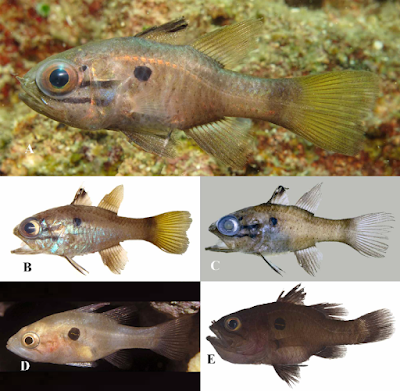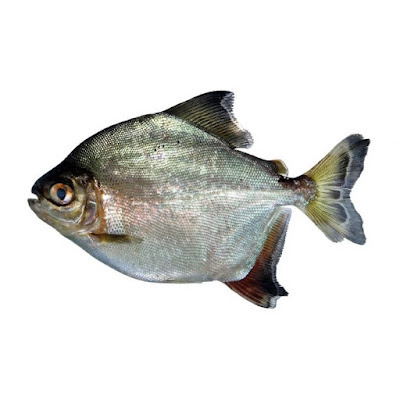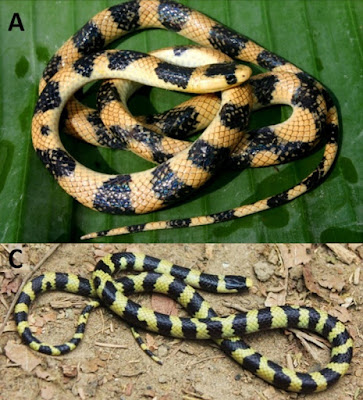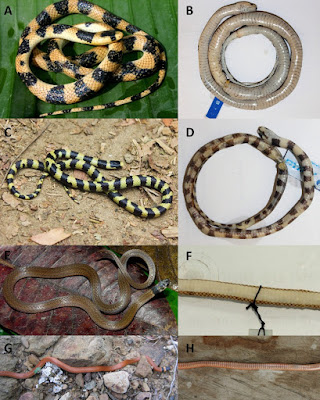[Most Recent Entries] [Calendar View]
Tuesday, December 13th, 2016
| Time | Event | ||
| 1:54p | [Ichthyology • 2011] Apogonichthyoides erdmanni • A New Cardinalfish of the Genus Apogonichthyoides (Perciformes, Apogonidae) from Raja Ampat Islands, Western Papua, Indonesia, with A Key to Species
Abstract Another deep-water cardinal fish of the genus Apogonichthyoides is described from Fiabacet Island, Western Papua, Indonesia. Collected at 73 m, Apogonichthyoides erdmanni has very distinctive markings on the head and body. It is brown with a dark spot on the body below the anterior lateral line, two slightly darker body bars and darker markings on the head, all similar features to those of the Philippine species Apogonichthyoides uninotatus. The new species has vivid, horizontal dark cheek and post-ocular marks, a small oval spot between the eye and tip of upper preopercular arm, yellowish anal, second dorsal and caudal fins, a narrow basicaudal bar less than 1/3 the length of the caudal peduncle, a vertical bar under the posterior half of the second dorsal-fin base reaching the base of the anal fin, small dark spots on the lower half of the body onto the lower portion of the caudal peduncle and a body spot smaller than the pupil of the eye. Apogonichthyoides uninotatus has a faint diagonal cheek mark, a faint horizontal post-ocular mark, a faint dash between the eye and the tip of the upper preopercular arm, brownish anal, second dorsal and caudal fins, a broad basicaudal bar more than 2/3 the length of the caudal peduncle, a broad body bar as a chevron including all of the second dorsal-fin base reaching the base of the anal fin, no small dark spots on the lower half of body and a body spot larger than the pupil of the eye. A key to twenty-two species of Apogonichthyoides is provided. Keywords: Apogonichthyoides erdmanni; species key; Apogonidae; cardinalfish Etymology. Named for Mark Erdmann of Conservation International, Indonesia Marine Program, who collected and photographed the type specimen. Mark has worked closely with the second author for the past six years and is responsible for numerous new discoveries, resulting from his deep scuba collections around the East Indian region. Habitat. The specimen was collected at 73m at the base of a sheer drop off exposed to moderate to strong cur-rents. The specimen was sheltering under a large block of dead coral rubble that rested on a moderate, silty sandslope. Thomas H. Fraser and Gerald R. Allen. 2011. A New Cardinalfish of the Genus Apogonichthyoides (Perciformes, Apogonidae) from Raja Ampat Islands, with A Key to Species. Zootaxa. 3095; 63-68. http://www.mapress.com/j/zt/article/view/1 | ||
| 2:17p | [Ichthyology • 2016] Myloplus lucienae • A New Large Myloplus Gill 1896 (Characiformes: Serrasalmidae) from rio Negro basin, Brazilian Amazon
Abstract Myloplus lucienae, new species, is described from the blackwater tributaries of the rio Negro basin. It is one of the few Myloplus species typically found in rapid areas of the Guiana Shield. It is diagnosed from congeners by the combination of an elongated body, small prepelvic spines that reach anteriorly just to the middle of the abdomen between verticals through pectoral- and pelvic-fin origin, and large scales on flanks resulting in smaller scale counts. Keywords: Pisces, Neotropical fishes, Myleus, taxonomy, Alfred Russell Wallace, Ostariophysi Etymology. Myloplus lucienae is named in honor of Luciene Maria Kassar Borges in recognition of her pioneer attempt to organize the knowledgement on the herbivorous Serrasalmidae from the rio Negro basin. Andrade, Marcelo C., Rafaela P. Ota, Douglas A. Bastos and M. Jégu. 2016. A New Large Myloplus Gill 1896 from rio Negro basin, Brazilian Amazon (Characiformes: Serrasalmidae). Zootaxa. 4205(6); 571–580. DOI: 10.11646/zootaxa.4205.6.5 | ||
| 3:57p | [Herpetology • 2016] Tantilla tjiasmantoi • A Large and unusually Colored New Snake Species of the Genus Tantilla (Squamata; Colubridae) from the Peruvian Andes
Abstract A new colubrid species of the genus Tantilla from the dry forest of the northern Peruvian Andes is described on the basis of two specimens, which exhibit a conspicuous sexual dimorphism. Tantilla tjiasmantoi sp. nov. represents the third species of the genus in Peru. The new species is easily distinguished from its congeners by the combination of scalation characteristics and the unusual transversely-banded color pattern on the dorsum. A detailed description of the skull morphology of the new species is given based on micro-computed tomography images. The habitat of this new species is gravely threatened due to human interventions. Conservation efforts are urgently needed in the inter-Andean valley of the Maranon River. Keywords: Dry forest, Endemic, Skull morphology, Osteology, Hemipenes morphology, La Libertad, Inter-Andean valley, Phylogenetic relationship, Serpentes, Reptilia, Micro-computed tomography Etymology: The species is dedicated to Wewin Tjiasmanto (Indonesia) in recognition of his support of nature conservation and taxonomic research through the BIOPAT initiative Claudia Koch and Pablo J. Venegas. 2016. A Large and unusually Colored New Snake Species of the Genus Tantilla (Squamata; Colubridae) from the Peruvian Andes. PeerJ. 4; e2767. DOI: 10.7717/peerj.2767 |
| << Previous Day |
2016/12/13 [Calendar] |
Next Day >> |








